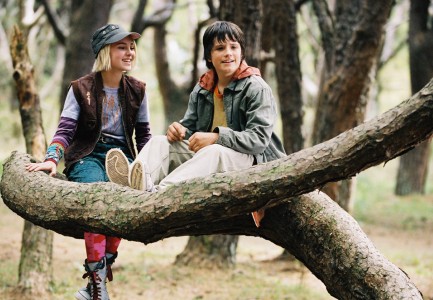
Last week my library discussion group talked about the children’s classic and Newberry award winner Bridge to Terabithia (1977), by Katherine Paterson. It has been our tradition each December to choose a children’s book in honor of the holiday season. Bridge to Terabithia, we discovered, fits the season well. Warning: I reveal the ending in the following discussion.
Paterson’s book is about the friendship between a 10-year-old boy from rural Virginia, very poor, and the new girl in his class. She is there because her writer parents have relocated from Washington, D.C. in search of the simple life. In addition to being smart and cosmopolitan, she is well versed in fantasy literature and the two of them construct a fantasy world in the forest, which they call Terabithia.
What particularly sets this book apart from other children’s literature is that Leslie, the girl, dies in the creek that they must cross to reach Terabithia, and Jess spends the rest of the book trying to come to terms with her death.
It was the death of my oldest son, at age 21, that led me to Bridge to Terabithia . My friend and colleague Lois Stover, an authority on young adult fiction, gave me the book a month or two after the funeral. I wasn’t prepared for how it would open up emotional floodgates.
The strength of the book lies in its treatment of Jess’s interior dialogue with the world. Leslie gives him a perspective that opens his eyes to wonders beyond his rural life (so does a hippy art teacher), and we get to watch him grow into his strengths.
We also get to watch him wrestle with the tragedy. In unflinching fashion, Paterson captures the various forms that his denial and anger take.
This time when I read the book, I recalled the emotions my other two sons underwent following Justin’s death. I remember Toby, 16 at the time, crying for two hours upon first hearing the news and then finding himself not able to cry for the next two weeks. He told me that he felt guilty about not crying when everyone else was, and I had to assure him that his job was to feel whatever he was feeling, not what he thought he was supposed to feel.
I remember non-stop basketball games going on in our driveway as he and his friends (whose parents pulled them out of school to join him) dealt with the trauma through physical exertion. (In the book, Jess runs blindly.) I wonder if Toby, like Jess, felt the weird dislocation of simultaneously enjoying and feeling guilty for enjoying the sudden relaxation of routine and his position as the center of attention. Paterson accurately captures the strange and sometimes seemingly inappropriate thoughts that go through the minds of those in a state of shock.
There was another parallel with the book, an incident I didn’t learn about until weeks after the death. Darien, 18 at the time, was like Jess in that he felt he needed to return to the place of the drowning. Jess returns to Terabithia and then finds himself helping his little sister, who has followed him there. She has gotten stuck on a tree limb half way over the creek, and there is something healing in the way that he has to save her.
Darien swam in the very spot where Justin had drowned. That way, he later explained to me, the river would not have power over him. I suspect it was also a way of making it all real. Death can seem terribly abstract, even when it happens to someone close to us. Maybe that’s because it’s hard to wrap our minds around an absence. I know that Darien also had a cross tattooed on his ankle with Justin’s initials. Darien doesn’t do tattoos so maybe the pain and the mark were, again, a way of making the absent present.
I saw my boys grow from the experience, as Jess does. When Darien spoke at the memorial service, a power I had never seen before seemed to emanate from him. His advisor Michael Ellis-Tolaydo, one of the college’s theater faculty who recognizes when people on stage are channeling forces beyond them, noticed the same thing.
In Jess’s case, he sees his relationship with his little sister in a new way. He understands that he is to be a guide for her, as Leslie was a guide for him. Literally, the bridge to Terabithia is the planks that he puts across the creek so that she will be able to get across safely. The book ends with him ushering his sister across the bridge and announcing to Terebithia that its new queen has arrived. Metaphorically, the bridge is entry into a new sense of self. Leslie helped Jess make that journey and her spirit watches over them as he guides his sister. Some day, he tells May Belle, she will bring their youngest sister over and the tradition will continue.
So how is Bridge to Terabithia a book for the season? Well, this is a time of cold and scarcity, as various religious festivals acknowledge. Hanukkah, the Jewish festival of light, lights candles in defiance of the ever darkening days. The pagan winter solstice celebration calls for the return of the sun, and Christians celebrate the birth of the Son. This week I will be writing about how the greatest Christmas stories and poems are powerful because they acknowledge the dark as well as the light.
I felt my darkness acknowledged when I read the book years ago. That in itself was a comfort. There was also comfort in Paterson’s assurance that, even after death, our loved ones continue to look over us. I had not had occasion to think about this before Justin died. I believe it now, and that belief is a light that sustains me when the darkness threatens to return.

